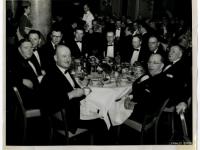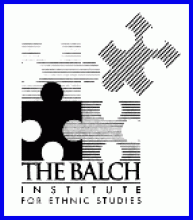By using primary sources, this activity introduces students to the concept of fraternal societies and mutual aid associations, their defining characteristics, the types that existed, their economic and social roles in people’s lives, and how and why they grew and then declined in membership. Students explore the diversity of the organizations among immigrants, African Americans, and the majority population and make some gross comparisons among them.
Ethnic Fraternal Societies and Mutual Aid: An American Tradition with Old World Roots
Ethnic Fraternal Societies and Mutual Aid: An American Tradition with Old World Roots
Essential Questions
Objectives
Students will:
- Understand the functions and role of fraternal societies and mutual aid in the lives of immigrants and African Americans through the examination of primary and secondary sources.
- Evaluate the role of voluntary societies in terms of their functions in civil society in the past and in contemporary society through the sources in the lesson as well as outside research .
Other Materials
Ethnic Societies: An American Tradition with Old World Roots
Primary sources:
Abraham Lincoln Society:
Note “Dear Brother” (found inside cover of Record of Membership Dues, 1939-51)
Friendly Sons of St. Patrick:
Explanation of the medal of the Friendly Sons of St Patrick
Societa` Castrogiovannesi di Mutuo Soccorso Cooperativa Napoleone Colajanni:
Domanda di Ammissione (Request for Admission)
Societa` di Mutuo Soccorso Maria S.S. del Soccorso di Sciacca:
Ladies PA Slovak Catholic Union:
Constitution and By-Laws of Junior Order: page 1, page 2-3, page 4-5, page 6-7, page 8-9, page 10-11, pages 12-13, page 14-15
Presbyterian Beneficial Union Lodge:
Presbyterian Union Lodge Financial Pamphlet: cover, inside
Zivena Beneficial Society (Slovak):
Membership Certificate of Anna Wysocki
Suggested Instructional Procedures
1. Print out copies and have students read “Ethnic Societies: An American Tradition with Old World Roots.”
2. Print out copies of the primary sources and student worksheet and give each student a copy.
3. If students have internet access, they can research the history of a particular mutual aid or fraternal society. Many that still exist have their own websites; some are listed in this lesson. In class or for homework, write a 250–500-word essay in response to the question:
- Using the information you read in the background reading, your review of the documents, and in your library/internet search (if you completed this part), write a 250–500 word essay on the following topic: Describe the types of services and activities immigrant associations provided for minorities and new immigrants during the 19th and 20th centuries. Discuss the purpose of their formation and how these associations did or did not contribute significantly to the adjustment of immigrants to America
4. The last goal of this activity is for the class to form its own fraternal society or mutual aid association. Students will have read the primary source document “Constitution and By-Laws of the Junior Order of the Ladies Pennsylvania Slovak Catholic Union” and have their completed worksheet. This exercise will help them write the by-laws for the society they create. The class should arrive at a joint decision about what kind of association it wants and how it will function by using the following criteria:
- Beneficial, fraternal, social only or a combination (local only or national)
- Modeled after a historic society or a contemporary one
- Create a name and by-laws for your society
- Name and elect officers
- Design a certificate, badge, or banner that represents the organization you have created. (Many society web sites have examples of insignia).
Vocabulary
Americanization: A process whereby immigrants become assimilated into American life. During the first two decades of the twentieth century, Americanization was an organized social movement. Some proponents feared the huge influx of immigrants and felt that they must reject their own cultural heritage and adopt American values and customs. Others took a positive view of what immigrants could contribute culturally to American life. These people wanted to ease immigrants’ adjustment to their adopted country.
Assimilate: A process whereby immigrants adopt the customs and attitudes of the prevailing culture
Ethnicity: A sense of peoplehood; of or relating to a group of people who share a common sense of national, religious, linguistic, or cultural heritage.
Fraternal society: A type of voluntary association based on a system of affiliated but decentralized lodges. The Sons of Italy is an example of a national ethnic fraternal association that is still active.
Laissez-faire: Non-intervention in the affairs of others; also, an economic policy that opposes any more than minimum government intervention in commerce.
Mutual aid: A system of self-help whereby a group of people band together to provide assistance for one another.
Mutual assistance: See “Mutual aid.”
Nativism: A policy that was especially popular in the United States in the nineteenth century that favors the interests of established inhabitants over those of immigrants. (nativistic, adj.)
Race: A term that is problematic from both a scientific and social point of view. Physical anthropologists in the seventeenth and eighteenth centuries adopted systems of racial classifications that were based on observable characteristics such as skin color, hair type, body proportions, and skull measurements, in order to categorize human populations into distinct groups. Scientists today use the biological aspect of race to look at genetic characteristics such as blood groups rather than as observable physical features. These characteristics seldom coincide neatly with those used previously. Today many cultural anthropologists consider race to be a term that has no real basis in biology and thus has no objective validity.
Racism: 1. The belief that race accounts for differences in human character or ability and that a particular race is superior to others. 2. Discrimination or prejudice based on race.
Social Darwinism: set of theories that incorrectly interprets and then applies Charles Darwin’s theory of biological evolution to human social relations. The movement’s most infamous proponent was English philosopher Herbert Spencer who wrote his book, Progress: Its Law and Cause, in 1857, in which he outlined his idea that all human progress evolved from simple to complex in the inevitable struggle of the survival of the most fit. He applied his ideas to the concepts of race and class. He ranked different societies on a linear scale of progress in which he placed the English at the top with all other cultures appearing below it. Spencer believed that efforts to change what was a slow deliberate pace of the progression of humans would be useless. Spencer’s ideas gained popularity in the United States in the 1870s for support of the status quo and offered easy justification for a laissez-faire attitude toward unfair political, labor, and social practices.
Related Resources for Students

Plans in this Unit
Grade Level
Duration
Standards/Eligible Content
Note
This lesson was created as part of a series about immigration that was placed on an older HSP website and was not created in the format we presently use. Therefore, please excuse some discrepancies in formatting and lack of fully digitized sources.
About the Author
This lesson was created by Joan Saverino and updated by Clara McGrath and Eden Heller, Education Interns, Historical Society of Pennsylvania.
Attention Teachers!
Let us know how you used this plan and be featured on our site! Submit your story here.


